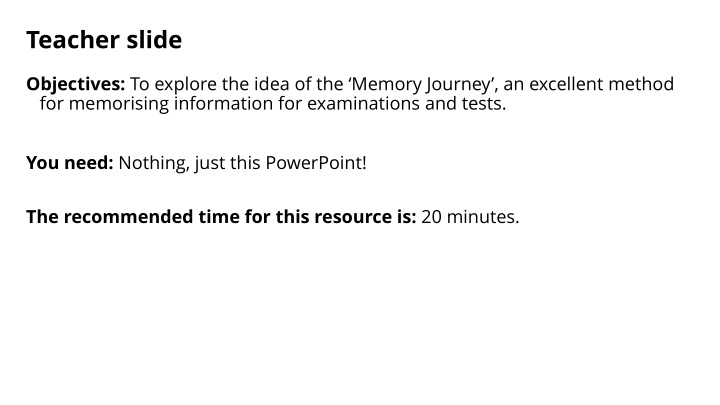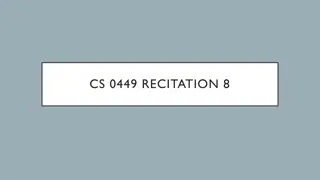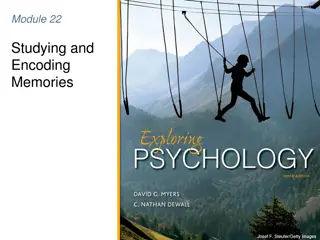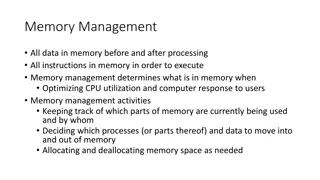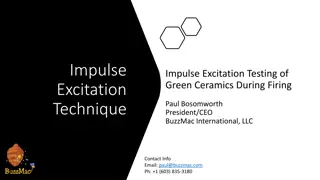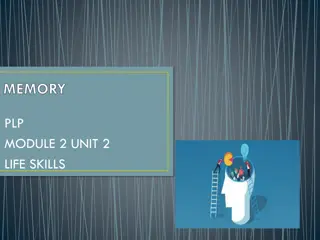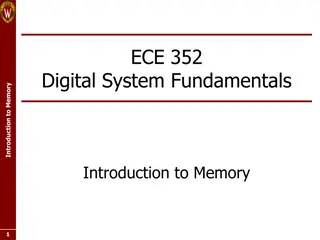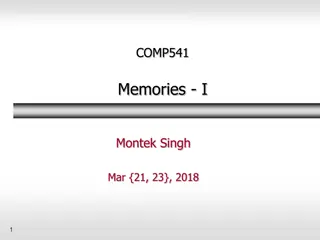Enhancing Memory with the Memory Journey Technique
Explore the concept of the Memory Journey as a powerful method for memorizing information efficiently. Discover how this technique leverages our senses, such as smell and visual memory, to create vivid memory associations. Follow along step-by-step with visualizations involving your home, family, and exciting scenarios to enhance your memory retention for exams and tests.
Download Presentation

Please find below an Image/Link to download the presentation.
The content on the website is provided AS IS for your information and personal use only. It may not be sold, licensed, or shared on other websites without obtaining consent from the author.If you encounter any issues during the download, it is possible that the publisher has removed the file from their server.
You are allowed to download the files provided on this website for personal or commercial use, subject to the condition that they are used lawfully. All files are the property of their respective owners.
The content on the website is provided AS IS for your information and personal use only. It may not be sold, licensed, or shared on other websites without obtaining consent from the author.
E N D
Presentation Transcript
Teacher slide Objectives: To explore the idea of the Memory Journey , an excellent method for memorising information for examinations and tests. You need: Nothing, just this PowerPoint! The recommended time for this resource is: 20 minutes.
Revision Style 2: The Memory Journey
The Memory... what? The older you get, the more information you ll be expected to know for your exams. By the time you get to your GCSEs and then Sixth Form, your exams are no longer pure memory tests you re expected to be able to understand and analyse information for questions, rather than just regurgitating it. It makes sense to have easy ways of memorising large amounts of information, but how can we do this effectively, without stress, and in an unusual way?
The Memory Journey The Memory Journey uses the strongest tools that we have at our disposal for memory: our senses. The sense of smell is our strongest memory sense think about the way in which the smell of something can instantly transport you to a memory from a long time ago. Our visual memory is also very strong, and the Memory Journey uses this to help memorise information for exams and tests.
The Memory Journey First, visualise your home.
The Memory Journey Second, imagine opening your front door. Immediately, a bucket of water falls on you, drenching you.
The Memory Journey Next, you see your whole family stood in the entrance, holding a massive bunch of red balloons. They all shout Happy Birthday!
The Memory Journey Next, they show you into your front room. The present they ve got you is loads of Duracell bunnies, who run around and go bezerk.
The Memory Journey Next, you smell a freshly baked birthday cake in your kitchen. You go through, and start eating a gigantic cake covered in mixed berries.
The Memory Journey Suddenly, Boris Johnson walks in, shakes you by the hand and says Happy birthday!
The Memory Journey Boris tells you that he s bought you a present and it s parked outside. You run out, and, waiting there for you, is a brand new, shiny red Lamborghini.
The Memory Journey Next, as you approach the car, a Knight in shining armour climbs out of the front seat. They open up their visor, revealing themselves to be whoever your dream Knight would be.
The Memory Journey Next, overwhelmed by the excitement of the moment, you faint. Fortunately, this means that the Knight has to give you the kiss of life, breathing oxygen back into you.
The Memory Journey Unfortunately, the Knight then turns to you and tells you that you have terrible breath. They hand you a tube of toothpaste.
The Memory Journey Finally, as you lie there heartbroken, you look up at the roof of your house, and see a giant, flashing, red neon sign that says Happy Birthday .
The Memory Journey Run through the Memory Journey, and see how much of it you can remember. Did you find it easy to remember? Why? There s a lot of sensory memory there: lots of visual, touch, sound, smell and taste memories as part of it. Does anyone have any idea of what we ve just learnt?
What weve learnt We ve just learned the first ten elements of the Periodic Table. Confused? Let s go through them.
1 Bucket of Water The primary constituent of water is Hydrogen, the First Element.
2 - Balloons Balloons that float are filled with Helium, the Second Element.
3 Batteries The most common type of batteries are Lithium, the Third Element.
4 - Cake The cake was covered in berries, reminding us of Beryllium, the Fourth Element.
5 - Boris Boris Johnson, in turn, reminds us of Boron, the Fifth Element.
6 Lamborghini A Lamborghini is a type of car, reminding us of Carbon, the Sixth Element.
7 - Knight The Knight in shining armour makes us think of Nitrogen, the Seventh Element.
8 Kiss of Life In the kiss of life, the Knight breathes Oxygen into you, the Eighth Element.
9 Toothpaste One of the most common ingredients in toothpaste is Fluoride, the Ninth Element.
10 Neon Sign Finally, a neon sign contains, you guessed it, Neon, the Tenth Element.
Application of the Memory Journey We have just quickly and easily learned the first ten elements of the Periodic Table. You could learn the whole lot in about half an hour, as long as you have clear enough images, senses and a journey. This technique removes the lengthy and, often, frustrating process of learning notes, and means you can focus on practicing and applying your knowledge in exams and tests instead. Why not try creating a new Memory Journey now?
